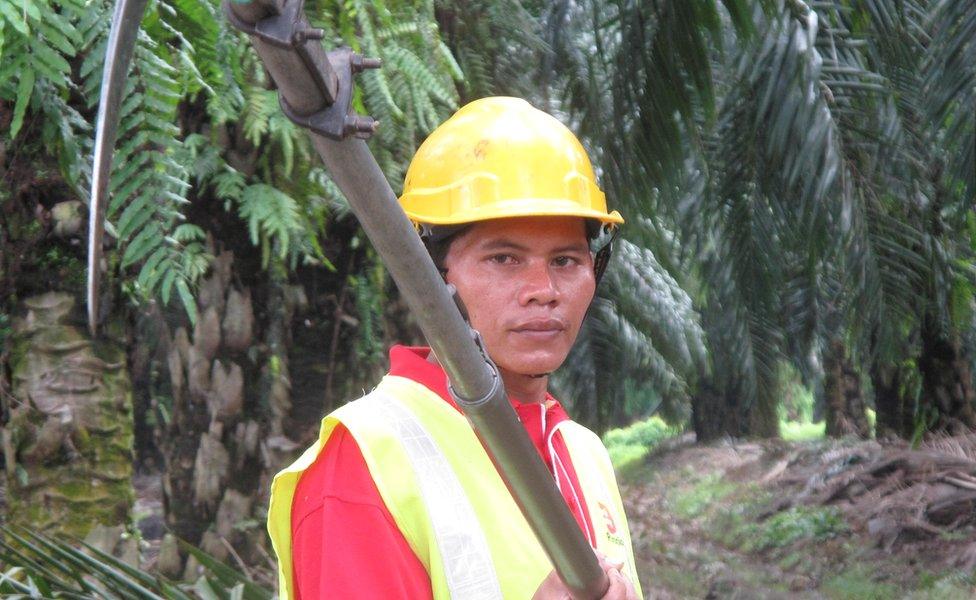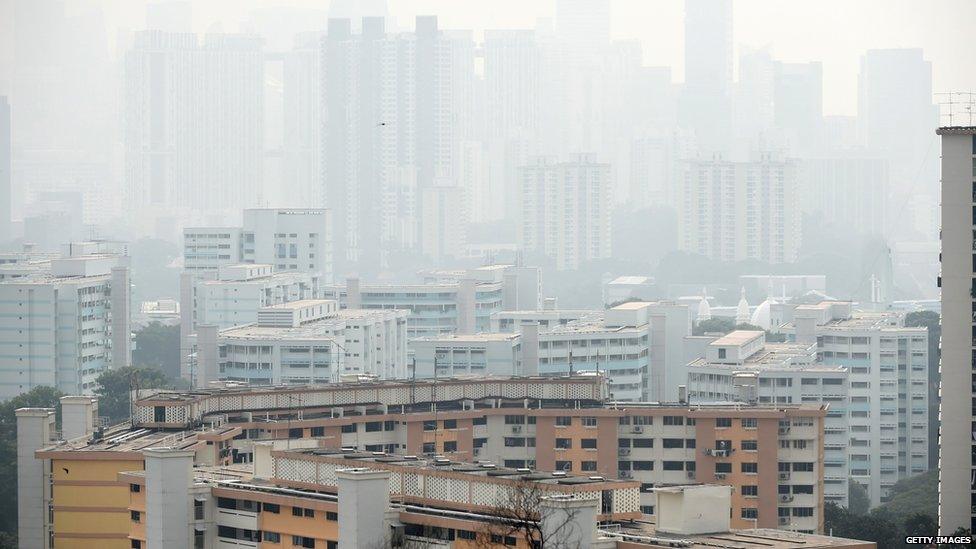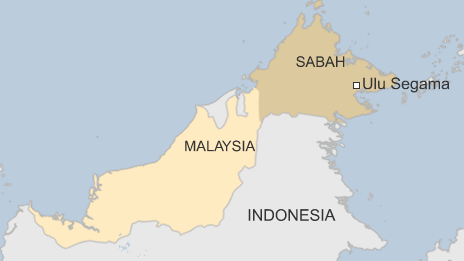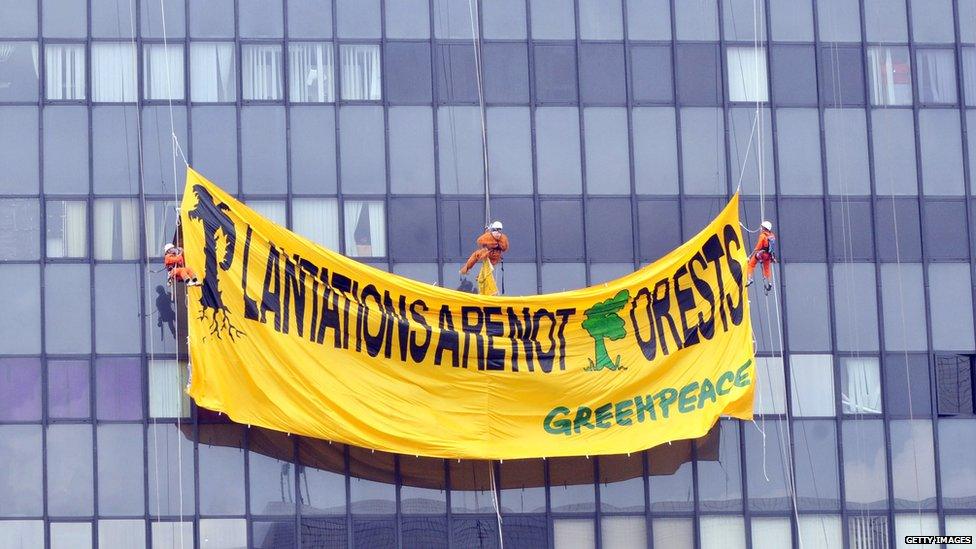Is Malaysia's palm oil worth the cost?
- Published
A Sabah district forestry officer talks about trying to preserve the habitat of the orangutan
Deep in the dense jungles of Borneo, a female orangutan hangs from a tree branch with one arm to form a straight line.
Her eyes are locked on us and we freeze. The men who work in the Ulu Segama forest reserve, external in Malaysia's Sabah state say it's safe to go closer to the endangered ape, but we cannot be certain.
Orangutans are territorial and this is one of the few left in the wild. Their plight has been blamed on palm oil.
"The impact of the cultivation of oil palm plantations on orangutans is devastating, it has wiped out virtually their entire habitat to this point," says Doug Cress, co-ordinator for the United Nations' Great Apes Survival Partnership. , external
However, he says it's not too late to save the orangutans as long as consumers insist on sustainably produced palm oil.

Palm oil cultivation and logging are key reasons for loss of forest in the last 40 years
Demand for the vegetable oil is expected to rise by 50% over the next decade.
The 'golden crop'
In theory, the oil palm tree couldn't be more environmentally friendly.
Its spiky reddish-brown fruit bunches ooze out oil so cheap and clean that Europe wants to put it in its cars as biodiesel.

The oily and easily grown fruits of the palm have lifted many farmers in the region out of poverty
Yet it's also versatile enough to be in half the products in our supermarkets, such as bread, soap, lipstick and even dog food.
"This is definitely the golden crop", says Khairudin Hashim, a senior manager with palm oil giant Sime Darby.
Malaysia, along with Indonesia, produces more than 80% of the global supply of palm oil.
It has lifted many poor farmers out of poverty, but at what cost?

Plantation companies like Sime Darby are coming under pressure to show they are committed to sustainabilty
Every year, forest fires are set in Indonesia to clear land for palm oil. During the dry season, the smoke chokes the region.
In a new study, researchers with the World Wide Fund for Nature (WWF) estimate that on the island of Borneo - divided between Malaysia, Indonesia and tiny Brunei - 30% of the forest has vanished over the last four decades mainly because of oil palm plantations and logging.
Pressure from green groups has forced big players in the palm oil industry, including Sime Darby, to show it cares about the planet.
"Right now 95% of our products that come from the plantations are sustainable," says Khairudin Hashim, the company's head of sustainability.
They are certified through the Roundtable on Sustainable Palm Oil (RSPO, external) - a not-for-profit group that brings together palm oil growers, traders and conservationists.
About 20% of the world's palm oil supply is considered sustainable.

Singapore has been badly hit by the haze from forest clearance elsewhere in the region
To be certified, producers have to follow strict guidelines, external, such as fair treatment of workers, no land grabs, no chemical pesticides, or harming of orangutans and peat lands.
It also means that above all, no virgin rainforests can be cut down in the making of palm oil.
The rules are not legally binding and campaign group Greenpeace has in the past accused RSPO members of using suppliers who break the rules.
While Mr Khairudin acknowledges there may be some "bad hats" in the industry, he says Sime Darby has never cleared pristine jungles.
"Essentially we don't cut forest," says Mr Khairudin.
"In Malaysia it was rubber before. It was a forestry and we are now planting again a forestry in the form of the oil palm tree," he says.

However, the Friends of the Earth Malaysia chapter spokesperson, Mohideen Abdul Kader, says Sime Darby's argument is "illogical."
"What we need is a regeneration or rehabilitation of these so-called secondary forests so that they will become high conservation forests," he says.
His organisation does not believe palm oil can be sustainable.
"Modern agricultural practice cannot produce sustainable products. It's based on clearing of large tracts of land, very often forest land," he says.
Does it pay to be sustainable?
There's also resistance within the industry. Only half of the world's certified sustainable palm oil is currently bought.
Industry expert M.R. Chandran, who helped start RSPO to change the image of the industry, says it comes down to cost because palm oil producers can spend up to an extra $15 per metric tonne of palm oil to certify it.
"To some growers it is a lot," he says.
Mr Chandran adds that there is a big fight between producers and manufacturers who don't want to pass the extra cost down to the consumer.
Alternatives to palm oil?
It won't be easy to move away from palm oil.
The palm tree is up to 10 times more efficient than other crops such as soybeans, rapeseed and canola in terms of the amount of land it needs.

Environmental groups have long protested against old forests being replaced with plantations
"If indeed expansion of the oil palm is prevented then the slack will probably be taken up by the other crops, which will have even worse outcomes for forest and biodiversity loss," says research scientist John Raison with the Australian national science agency, CSIRO.
He's now leading a study funded by several of the world's biggest palm oil industry players to determine what types of land should not be converted into plantations based on the amount of carbon stored in the trees.
It's a controversial topic.
However, Mr Raison says there needs to be a balance.
"If we set the [carbon] emissions thresholds very low, most areas will be excluded from development... and that's probably not acceptable from a government's point of view because they are looking to alleviate poverty," he says.
For now, the Ulu Segama forest reserve is safe and local officials, along with Sime Darby and conservation groups like WWF have pitched in to replant trees for the orangutans.